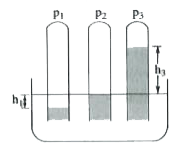The intermolecular forces operating between two constituent particles depends on the distance between the centres of the molecules. Dipole-dipole interactions are inversely proportional to 3rd power of the distance where as dipole induced dipole interaction are inversely proportional to the sixth power of intermolecular distances.
The forces in dry ice are proportional to (r = intermolecular distance)Solution in Telugu
1r3
1r4
1r6
1r2
Step by step video & image solution for The intermolecular forces operating between two constituent particles depends on the distance between the centres of the molecules. Dipole-dipole interactions are inversely proportional to 3rd power of the distance where as dipole induced dipole interaction are inversely proportional to the sixth power of intermolecular distances. The forces in dry ice are proportional to (r = intermolecular distance) by Chemistry experts to help you in doubts & scoring excellent marks in Class 12 exams.
Updated on:21/07/2023Topper's Solved these Questions
- STATES OF MATTER BOOK - AAKASH SERIESCHAPTER - STATES OF MATTER EXERCISE - ADDITIONAL PRACTICE EXERCISE- PRACTICE SHEET (ADVANCED) (LINKED COMPREHENSION TYPE QUESTIONS) (PASSAGE- III)
3 Videos
- STATES OF MATTER BOOK - AAKASH SERIESCHAPTER - STATES OF MATTER EXERCISE - ADDITIONAL PRACTICE EXERCISE -PRACTICE SHEET (ADVANCED) (LINKED COMPREHENSION TYPE QUESTIONS) (PASSAGE- IV)
2 Videos
- STATES OF MATTER BOOK - AAKASH SERIESCHAPTER - STATES OF MATTER EXERCISE - ADDITIONAL PRACTICE EXERCISE-PRACTICE SHEET (ADVANCED) (LINKED COMPREHENSION TYPE QUESTIONS) (PASSAGE- I)
3 Videos
- SOLUTIONS BOOK - AAKASH SERIESCHAPTER - SOLUTIONS EXERCISE - Objective Exercise -4
50 Videos
- STOICHIOMETRYBOOK - AAKASH SERIESCHAPTER - STOICHIOMETRYEXERCISE - PRACTICE SHEET (ADVANCED) (INTEGER TYPE QUESTION)
2 Videos
Similar Questions
Density of gas is inversely proportional to absolute temperature and directly proportional to pressure
⇒d∝PT⇒dTP = constant ⇒d1T1P1=d2T2P2
Density at a particular temperature and pressure can be calculated bousing ideal gas equation
PV=nRT⇒PV=massmolar mass (M)xRT
P×M=massvolume×RT⇒P×M=d×RT
d=PMRT
Which of the following has maximum density?
View SolutionAt a particular temperature and pressure for a real gas Van der Waal's equation can be written as:
(P+aV2m)(Vm−b)=RT

where Vm is molar volume of gas. This is cubic equation in the variable Vm and therefore for any single value of P & T there should be 3 values of Vm. Which are shown in graph as Q, M and L.
As temperature is made to increase at a certain higher temperature the three values of Vm becomes identical. The temperature, pressure & molar volume at point X are called Tc, Pc & Vc for real gas. The compressibility factor in terms of Pc, Vc and T is called Zc.
The expression of Van dcr Waal's constant 'a' can be given as
View SolutionConsider gases confined by a liquid, as shown below.
Density of the liquid = d.gmL−1
h1 and h3 in mm and p1,p2 and p3 in mm Hg.

Select correct relation for pressure p3
View SolutionAssertion : Molarity of a solution decreases with an increase of temperature
Reason : As temperature increases volume of the solution increases.
View SolutionAmmonia is oxised by oxygen to give nitric oxide and water. The weight of water produced per gram of nitric oxide is 0.1×xg. What is value of d.
View SolutionThe intermolecular interaction that is dependent on the inverse cube of distance between the molecules is
View Solutionthe interaction energy of London force is inversely proportional to sixth power of the distance between two interaction particles but their mahnitude depends upon
View SolutionThe interaction energy of London force is inversely proportional to sixth of the distance between two interacting particles but their magnitude depends upon
View SolutionIntermolecular interaction that is dependent on the inverse cube of distance between the molecule is-
View Solutionनाइलॉन में अन्तराअणुक बल द्विध्रुव - द्विध्रुव अन्योन्य क्रिया है।
View SolutionThe intermolecular interaction that is dependent on the inverse cube of distance between the molecule is :
View SolutionThe intermolecular forces operating between two constituent particles depends on the distance between the centres of the molecules. Dipole-dipole interactions are inversely proportional to 3rd power of the distance where as dipole induced dipole interaction are inversely proportional to the sixth power of intermolecular distances.
In which of the following the extent of interaction is proportional to 1r6 where (r = intermolecular distance)
View Solutionलंडन बल (London force) की अन्योन्य क्रिया ऊर्जा, अन्योन्य क्रिया करने वाले दो कणों के मध्य की दूरी की छठवीं घात के व्युत्क्रमानुपाती होती है लेकिन उनका परिमाण निम्न पर निर्भर करता है-
View Solutionthe interaction energy of London force is inversely proportional to sixth power of the distance between two interaction particles but their mahnitude depends upon
View SolutionThe intermolecular interaction that is dependent on the inverse cube of distance between the molecules is
View Solution
